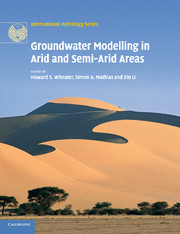Book contents
- Frontmatter
- Contents
- Contributors
- Preface
- Acknowledgements
- 1 Groundwater modelling in arid and semi-arid areas: an introduction
- 2 Hydrological processes, groundwater recharge and surface-water/groundwater interactions in arid and semi-arid areas
- 3 Conceptual models for recharge sequences in arid and semi-arid regions using isotopic and geochemical methods
- 4 Groundwater flow and transport
- 5 Performing unbiased groundwater modelling: application of the theory of regionalised variables
- 6 Groundwater vulnerability and protection
- 7 Variable density groundwater flow: from modelling to applications
- 8 Sustainable water management in arid and semi-arid regions
- Index
- Plate section
- References
6 - Groundwater vulnerability and protection
Published online by Cambridge University Press: 06 December 2010
- Frontmatter
- Contents
- Contributors
- Preface
- Acknowledgements
- 1 Groundwater modelling in arid and semi-arid areas: an introduction
- 2 Hydrological processes, groundwater recharge and surface-water/groundwater interactions in arid and semi-arid areas
- 3 Conceptual models for recharge sequences in arid and semi-arid regions using isotopic and geochemical methods
- 4 Groundwater flow and transport
- 5 Performing unbiased groundwater modelling: application of the theory of regionalised variables
- 6 Groundwater vulnerability and protection
- 7 Variable density groundwater flow: from modelling to applications
- 8 Sustainable water management in arid and semi-arid regions
- Index
- Plate section
- References
Summary
INTRODUCTION
Groundwater is a particularly vital resource in arid and semi-arid areas owing to the scarcity of suitable surface-water resources and the high evaporation from surface-water storage. However, if it is also to be a reliable resource, able to meet current and future demand, it has to be managed effectively, not only in terms of quantity (i.e. abstraction) but also quality. Recent decades have seen substantial progress in the development of methods for remediating contaminated groundwater (Reddy,2008). However, because of the complexities associated with the removal and/or destruction of pollutants in the subsurface this is often both costly and time consuming. The maxim ‘prevention is better than cure’ is therefore an important one in groundwater resource management.
One of the key instruments for seeking to maintain good groundwater quality is groundwater protection policy. In most developed countries groundwater protection has been formally incorporated into legislation as a means to ensure good groundwater quality on a sustainable basis and as part of an integrated approach to environmental protection (e.g. EU, 2009). In practice, this is achieved through aquifer vulnerability mapping at the regional scale and source zone protection at the scale of local abstractions. This chapter summarises these two complementary approaches to groundwater protection and considers how they can be implemented in arid and semi-arid regions. This focus on climate is important, as the geological and hydrological conditions are generally very different from those in more temperate regions (Robins et al., 2007).
- Type
- Chapter
- Information
- Groundwater Modelling in Arid and Semi-Arid Areas , pp. 75 - 86Publisher: Cambridge University PressPrint publication year: 2010
References
- 2
- Cited by



